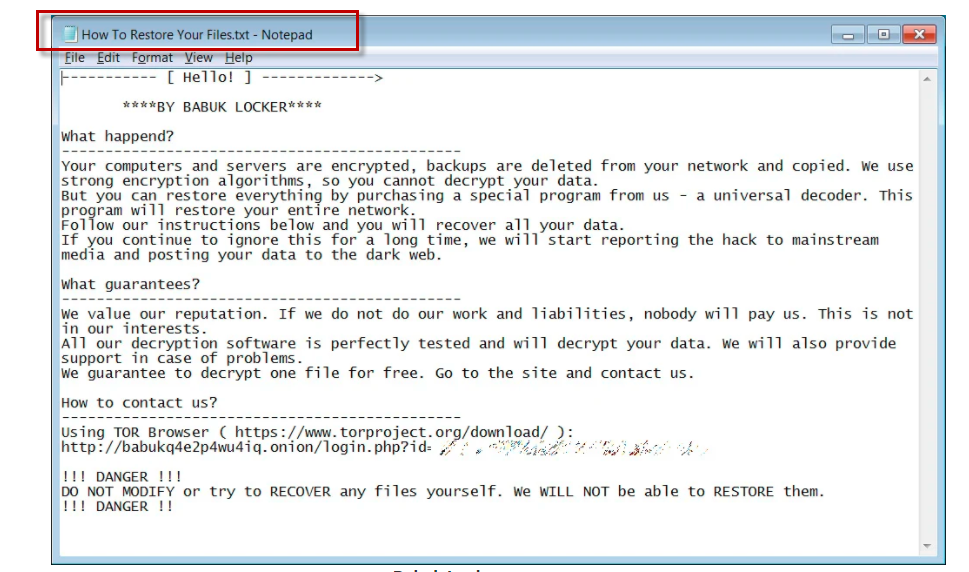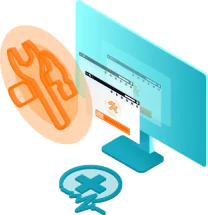Babyk
Babyk is a Ransomware virus that secretly converts your digital files into unreadable bits of data through encryption. In this way, Babyk keeps them inaccessible and demands a ransom to decrypt them.

The Babyk Ransomware ransom note
If all of your files have suddenly become unreadable and their file extensions have been replaced with some unfamiliar one, then your computer has most likely been infected with Babyk. This Ransomware virus leaves visible a ransom message with information and instructions on how to decrypt your files immediately after the file-encryption process gets completed. In those messages, it demands a ransom to be paid in order to send you the decryption key.
We’re sure you want your data back, and the question that has probably brought you here is if you can get it without paying a ransom. That’s why our “How to remove” team has prepared this article – to help you remove Babyk and save your money. If you remain with us, you will find a detailed removal guide, as well as some useful information on how you may potentially be able to get back some of your files.
The Babyk virus
The Babyk virus is a Ransomware infection that can render your files inaccessible without your knowledge. In order to do that, the Babyk virus uses a complex encryption algorithm that gets applied to each and every file.
Unfortunately, this malware is very sophisticated and is distributed in several different ways. If you want to avoid becoming a victim of Babyk, there are a number of things you need to watch out for. For instance, you need to be mindful of the websites you land on – some of them may be compromised by a Ransomware and you may not even know it. You also need to be particularly careful about possible Trojan Horse infections, as these can often deliver a Ransomware into the computers of their victims. But most commonly, you may catch such an infection if you open an infected email attachment or click on a misleading link or a fake advertisement, containing the malware. That’s why avoiding contact with questionable files, random pop-ups, and links is a good way to keep away from threats such as Babyk and Neer.
The Babyk file extension
The Babyk file extension is a special extension that the Ransomware virus applies to the encrypted files. Typically, the Babyk file extension is unreadable by any program and can be applied to a variety of regular files that become a target of the Ransomware.

The Babyk file virus ransomware
The moment it sneaks in the system, Babyk will immediately start encrypting your files and changing their file extensions so that you cannot open or use those files. When all the targeted files become encrypted, the virus will notify you about the attack with a message displayed on the screen. The message informs you that, if you pay a certain amount of money, you will receive a key to “release” your files.
Unfortunately, there is no way to know if the cyber criminals behind Babyk are going to give you a decryption key to open your files. That’s why we strongly advise that you not rush with the transaction unless you’ve reviewed and tried some other alternative solutions, like the ones we’re going to show you below.
SUMMARY:
| Name | Babyk |
| Type | Ransomware |
| Danger Level | High (Ransomware is by far the worst threat you can encounter) |
| Symptoms | Very few and unnoticeable ones before the ransom notification comes up. |
| Distribution Method | From fake ads and fake system requests to spam emails and contagious web pages. |
| Data Recovery Tool | Not Available |
| Detection Tool | Some threats reinstall themselves if you don't delete their core files. We recommend downloading SpyHunter to remove harmful programs for you. This may save you hours and ensure you don't harm your system by deleting the wrong files. |
Remove Babyk Ransomware
![]()
Some of the steps will likely require you to exit the page. Bookmark it for later reference.
Reboot in Safe Mode (use this guide if you don’t know how to do it).
![]()
WARNING! READ CAREFULLY BEFORE PROCEEDING!
*Read more details in the first ad on this page, EULA, Privacy Policy, and full terms for Free Remover.
Press CTRL + SHIFT + ESC at the same time and go to the Processes Tab. Try to determine which processes are dangerous.

Right click on each of them and select Open File Location. Then scan the files with our free online virus scanner:

After you open their folder, end the processes that are infected, then delete their folders.
Note: If you are sure something is part of the infection – delete it, even if the scanner doesn’t flag it. No anti-virus program can detect all infections.
![]()
Hold the Start Key and R – copy + paste the following and click OK:
notepad %windir%/system32/Drivers/etc/hosts
A new file will open. If you are hacked, there will be a bunch of other IPs connected to you at the bottom. Look at the image below:

If there are suspicious IPs below “Localhost” – write to us in the comments.
Type msconfig in the search field and hit enter. A window will pop-up:

Go in Startup —> Uncheck entries that have “Unknown” as Manufacturer.
- Please note that ransomware may even include a fake Manufacturer name to its process. Make sure you check out every process here is legitimate.
![]()
To remove parasite on your own, you may have to meddle with system files and registries. If you were to do this, you need to be extremely careful, because you may damage your system.
If you want to avoid the risk, we recommend downloading SpyHunter
a professional malware removal tool.
More information on SpyHunter, steps to uninstall, EULA, Threat Assessment Criteria, and Privacy Policy.
Type Regedit in the windows search field and press Enter. Once inside, press CTRL and F together and type the virus’s Name.
Search for the ransomware in your registries and delete the entries. Be extremely careful – you can damage your system if you delete entries not related to the ransomware.
Type each of the following in the Windows Search Field:
- %AppData%
- %LocalAppData%
- %ProgramData%
- %WinDir%
- %Temp%
Delete everything in Temp. The rest just check out for anything recently added. Remember to leave us a comment if you run into any trouble!
![]()
How to Decrypt Babyk files
We have a comprehensive (and daily updated) guide on how to decrypt your files. Check it out here.
If the guide doesn’t help, download the anti-virus program we recommended or try our free online virus scanner. Also, you can always ask us in the comments for help!




Leave a Comment